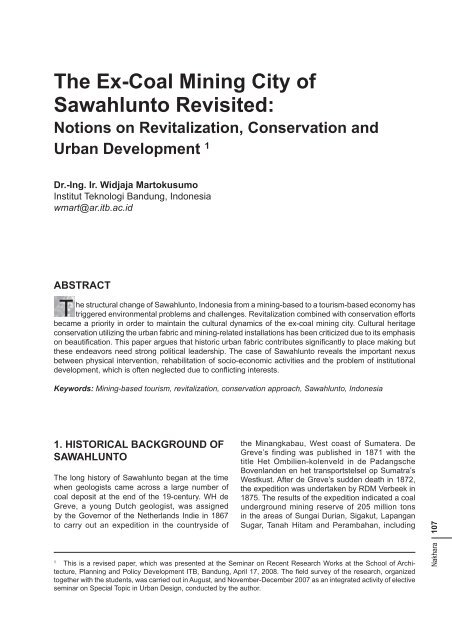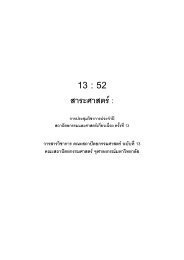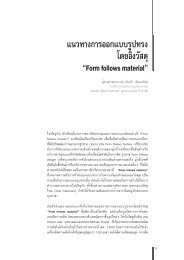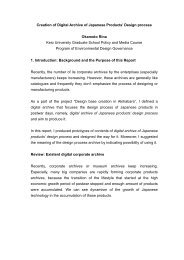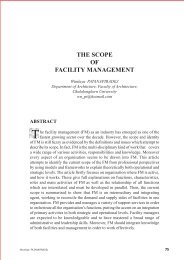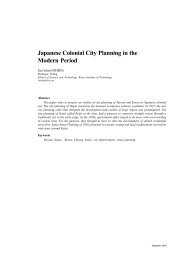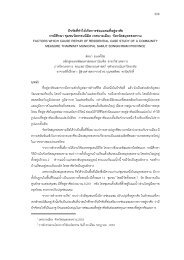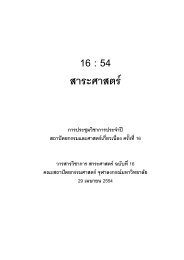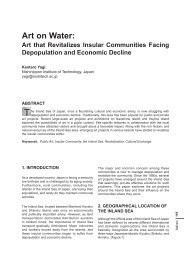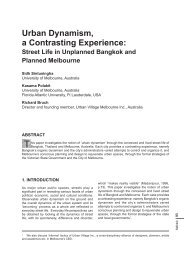Full Text PDF - Faculty of Architecture
Full Text PDF - Faculty of Architecture
Full Text PDF - Faculty of Architecture
Create successful ePaper yourself
Turn your PDF publications into a flip-book with our unique Google optimized e-Paper software.
The Ex-Coal Mining City <strong>of</strong> Sawahlunto Revisited:Notions on Revitalization, Conservation and Urban DevelopmentThe Ex-Coal Mining City <strong>of</strong>Sawahlunto Revisited:Notions on Revitalization, Conservation andUrban Development 1Dr.-Ing. Ir. Widjaja Martokusumowmart@ar.itb.ac.idABSTRACTThe structural change <strong>of</strong> Sawahlunto, Indonesia from a mining-based to a tourism-based economy hastriggered environmental problems and challenges. Revitalization combined with conservation effortsbecame a priority in order to maintain the cultural dynamics <strong>of</strong> the ex-coal mining city. Cultural heritageconservation utilizing the urban fabric and mining-related installations has been criticized due to its emphasisthese endeavors need strong political leadership. The case <strong>of</strong> Sawahlunto reveals the important nexusbetween physical intervention, rehabilitation <strong>of</strong> socio-economic activities and the problem <strong>of</strong> institutionalKeywords: Mining-based tourism, revitalization, conservation approach, Sawahlunto, Indonesia1. HISTORICAL BACKGROUND OFSAWAHLUNTOThe long history <strong>of</strong> Sawahlunto began at the timewhen geologists came across a large number <strong>of</strong>coal deposit at the end <strong>of</strong> the 19-century. WH deGreve, a young Dutch geologist, was assignedby the Governor <strong>of</strong> the Netherlands Indie in 1867to carry out an expedition in the countryside <strong>of</strong>the M Greve’s finding was published in 1871 with the 1875. The results <strong>of</strong> the expedition indicated a coal Sug 1 -seminar on Special Topic in Urban Design, conducted by the author.Nakhara 107
Dr.-Ing. Ir. Widjaja Martokusumothe surrounding areas <strong>of</strong> the Sawahlunto town, in 1887. Shortly thereafter, the town was settled in1888, the year when 5.5 million Gulden was investedby the colonial government <strong>of</strong> the Netherlands for 1894, the small town was connected to EmmaTeluk Bayur century, the coal mining operation in Sawahluntoroute from and to Sawahlunto, stopped operation intown. The Sawahlunto town is geographically locatedheart <strong>of</strong> Bukit Barisan Mountains, West Sumatera.Exploration and mining reached its heyday in the et al., Due to thevast coal mining operation, Sawahlunto was also Kota Arang history <strong>of</strong> its urban development cannot be separatedfrom the mining activities in West Sumatera. The as awhole. Despite the relatively short period <strong>of</strong> miningactivities, historical traces <strong>of</strong> the European industrialrevolution can be recognized in Sawahlunto,especially through the mining artifacts and the spatialby the new Indonesian government until the end <strong>of</strong> PerusahaanTambang Bukit Asam – Unit Produksi Ombilina state-owned company, was in charge <strong>of</strong>political interests, and socio-cultural obstacles ledto the introduction <strong>of</strong> an environmental-friendly institutionally based upon a new vision, which wasthe transformation from mining-based to tourismbasedeconomy. This development shift and itsassociation with the national decentralization policy Perda 6tahun 2003decentralization, the political will to execute miningbasedtourism for Sawahlunto became strongdespite some persistent small scale, and mostlyillegal mining activities, which are still in operation.Nakhara 108Figure 1.:Settlement structure <strong>of</strong> Sawahlunto in 1921 (Source: Redrawn after Sawahlunto 2020 (Kuswartojo, 2001))
The Ex-Coal Mining City <strong>of</strong> Sawahlunto Revisited:Notions on Revitalization, Conservation and Urban DevelopmentFigure 2a:Indonesia and West SumateraFigure 2b:The old town Sawahlunto (779 ha) and the expansion <strong>of</strong>the administrative area in 1990 (27,344ha)(Source: Sawahlunto 2020 (Kuswartojo, 2001))CULTURAL HERITAGESAWAHLUNTO: AN ISSUE OFDYNAMIC CITYthey reveal stories about stages in spatial production form came about directly through colonialization.In Sawahlunto the legacy <strong>of</strong> the past can still berecognized through the cultural layers <strong>of</strong> its urbanfabric. Thus, the richness <strong>of</strong> Sawahlunto’s urbanhistory, with its mix <strong>of</strong> local-indigenous cultures and Conserving the legacy <strong>of</strong> the past may also seema strange objective for a developing country, sincecultural heritage conservation, at least in the sensethan other social needs, such as poverty alleviationand the provision <strong>of</strong> new housing, transport andthe loss <strong>of</strong> cultural heritage as a result <strong>of</strong> uncriticalrevitalization or uncontrolled redevelopment <strong>of</strong>the urban fabric is becoming a serious concernto various developing cities in term <strong>of</strong> urban implemented a new development policy based onheritage conservation and mining-based tourism.This change in development policy has triggerednew environmental problems and social challenges improvements to the historic fabric have beenintegrated into the revitalization programs, mainlythe adaptive re-use <strong>of</strong> the historic urban fabric andmining-related installations. Only part <strong>of</strong> the industrialand mining heritage buildings and artifacts from thecolonial period in the old city have been preservedwhile several buildings nearby Sawahlunto areNakhara 109
Dr.-Ing. Ir. Widjaja MartokusumoNakhara 110mostly deserted. Consequently, conservationactivities have been criticized for their focus on Elsewhere, the while conservation and revitalization have becomeimportant issues in Indonesian urban developmentpolitics, there is, not a readiness and acceptancein the society at large. Heritage conservationcan be socially as well as politically vulnerablewhen the objects to be conserved were createdduring the colonial period, or if they are culturallyrelated to certain non-indigenous ethnic groups.or understanding among the actors with regard towhat heritage conservation is all about. associated with the introduction <strong>of</strong> new productiveuses, this not been the case in Sawahlunto. Thus,recent physical developments have brought littleimprovement to the quality <strong>of</strong> urban life. This raisessome questions regarding the Sawahlunto case suchHow can design and development control <strong>of</strong> new ultimately, how can environmental awareness,public participation and sustainable development beThis paper argues that any city’s historic fabricrevitalization is necessary in order to understand thecomplex relations between human beings and theprocess <strong>of</strong> spatial production in architecture and theurban fabric. In a broader sense, revitalization dealsexplicitly with physical interventions, rehabilitation<strong>of</strong> socio-economic activities and institutionaldevelopment. Consequently, efforts at revitalizationmust also be supported by a strong political will inorder to enhance the nexus between people as theinhabitants and their environment. In relation to suchstrong interdependent relationship between physicalforms/urban fabric and human behavior. TheSawahlunto case reveals that this relationship, dueand ignored.2. CONSERVATION ANDREVITALIZATION et al. early phase, historic conservation dealt simply withthe protection <strong>of</strong> individual buildings, structures andother artifacts, while in the second phase concernexpanded into area-bon the functional characteristics <strong>of</strong> areas and theactive economic use <strong>of</strong> protected buildings wasset up as a conservation concern in addition tothe visual, architectural and historical qualities <strong>of</strong>buildings. The preservation <strong>of</strong> form has implicationsfor urban function, and conservation therefore hasturned into an apparatus <strong>of</strong> urban management. change and the management <strong>of</strong> change per seet al.the physical and natural environment. It does not by a sense <strong>of</strong> use, which includes community needsand ecological concerns. The heritage conservationmovement has expanded its interests into areaswhere environmental concerns - i.e. natural orcultural landscape, topography, social and culturaltraditions, and other environmental objects - are moredominant than historical associations <strong>of</strong> a place. Withsuch an expanded concept <strong>of</strong> heritage conservation,potential objects for heritage conservation areincreasing. Conservation deals not only with thephysical dimensions, but it should ultimately be seenas a thorough effort to interpret and to appreciateimportant architectural and spatial forms. In essence,the objective <strong>of</strong> the conservation movement leadsto a cultural appreciation and broadens intellectualunderstanding. The utilization <strong>of</strong> architectural andurban fabric in accommodating new functional needscan be conceived as an attempt to appreciate andInevitably, historic urban quarters have to deal withon the other hand physical change is restricted andcontrolled in the interest <strong>of</strong> conservation. In suchquarters, the necessity <strong>of</strong> integrating the variousrequirements <strong>of</strong> conservation and revitalization, and<strong>of</strong> balancing economic progress with environmentalquality is particularly challenging. The paradigm<strong>of</strong> sustainability promotes sensitive utilization <strong>of</strong>existing urban fabrics - building and sites - and as aRevitalization can be understood as efforts toincrease the vitality <strong>of</strong> certain neglected urbanquarters through physical interventions with carefulconsiderations <strong>of</strong> social, cultural, economic andphysical characteristics. Revitalization focuseson generating economic development while
The Ex-Coal Mining City <strong>of</strong> Sawahlunto Revisited:Notions on Revitalization, Conservation and Urban Developmentan historic area. This could either be the indigenousregeneration <strong>of</strong> traditional activities <strong>of</strong> a locality ora restructuring <strong>of</strong> the area’s economic base withinits historic shell. The restructuring process hastwo related dimensions: functional and physical et al. cultural products and historical fabric in producing amore vibrant living environment.In revitalizing historic urban areas, highly visible,intervention is usually a short-term strategy to createfavorable conditions, which will attract economicinvestments. In the short-term, physical interventionscan result in an attractive, well-maintained publicrealm that projects a good image and encouragesdimension <strong>of</strong> revitalization is also required, since itis the productive utilization <strong>of</strong> the private realm thateventually pays for the maintenance <strong>of</strong> the public et al. should <strong>of</strong>fer attractiveness and a place for living. Inaddition to physical and economic concerns, socialrevitalization is also important. Social revitalizationenhances a sense <strong>of</strong> vitality within urban space.Evitalization that focuses on the social realm is alsoimperative.3. TRANSFORMATION ANDDEVELOPMENT POLICYSince the decline <strong>of</strong> coal production in Sawahlunto,there have been major changes in developmentpolicy, as follows:First, due to declining coal-mining operationin Ombilin, coal processing and transportation tons. Nevertheless, future coal exploration andmanagement has not been decided, since thesupport. million tons <strong>of</strong> coal has been explored, while the been excavated due to high operational cost. Coalmining production began declining in the period <strong>of</strong> coal mining production reached one million ton per Ongoing illegal coal mining activities in thesurroundings <strong>of</strong> Sawahlunto have increasedecological problems. Several ecologicalproblems arose when surface coal reserves inSawahlunto decreased. The ecological impactsdue to unorganized mining activities can beseen in the last few years. Such condition isexacerbated by growing activities <strong>of</strong> clandestine last few years, where deserted and neglectedcoal tunnels and mining shafts are vulnerable Second, the historic fabric in Sawahlunto is in decay, such as the processing plant and otherformer industrial installations in the surroundingarea <strong>of</strong> Sawahlunto. Only a small number <strong>of</strong> city are preserved as objects <strong>of</strong> tourist attractions,such as the old coal mine tunnel Mbah Suro, theformer Societet Goedang Ransoema few. Certainly, some new urban facilities andservices have been developed, but they can onlyurban quarters <strong>of</strong> Sawahlunto are in general neglect.The old city is designated as a quasi museum <strong>of</strong>former Ombilin coal mining activities in a very limitedsense. Standard facilities for a coal mining-basedtourism city can hardly be found. Moreover, thereare no adequate supporting modern amenities,and most <strong>of</strong> the existing infrastructure does notsupport contemporary needs. To some extent, thein Sawahlunto is the Sungai River Batang Ombilin.The river is now threatened by on-going clandestineexpansion <strong>of</strong> local settlements on valley slopes andthe ridges <strong>of</strong> surrounding mountain.Third, since the city was established, urbanizationhad not proceeded in an orderly manner. did not have any other resources except mining.Every single facility and need was adequatelysupported during the productive period <strong>of</strong> themining activities, but this has unfortunately notNakhara 111
Dr.-Ing. Ir. Widjaja MartokusumoNakhara 112been the case after the mine closure. Efforts to gain 1995 national population census, the populationpeople. Due to its geographical conditions, theSawahlunto extension led to a proliferation <strong>of</strong> tiny decrease in comparison to the last five years.One <strong>of</strong> the reasons is the partial resettlement <strong>of</strong> coaland reveals that the urban dynamic <strong>of</strong> Sawahluntowas solely dependent on mining activities.Fourth, the urban vision <strong>of</strong> the city Sawahluntotahun 2020 menjadi Kota Wisata Tambang yangBerbudaya emphasizes will initially focus on the historic urban quarters <strong>of</strong>Sawahlunto. The old town serves as a locus <strong>of</strong>important historic buildings and sites, which are some physical interventions <strong>of</strong> important objects inSawahlunto have altered important buildings, othershave retained the Indo-European architectural style,such as the coal processing plant, silos, railwaystation and a number <strong>of</strong> historic colonial buildings.Other facilities, such as the railway station building Goedang Ransoem, theSocietet still intact. The critical re-use <strong>of</strong> such buildings will bepart <strong>of</strong> the main development strategy for a heritagetrail and cultural tourism.4. SAWAHLUNTO: THE CULTURALMINING-BASED TOURISM CITY mentioned, tourism and theconservation <strong>of</strong> mining related artifacts have beenchosen as the main socio-cultural attraction formany urban authorities particularly in the region <strong>of</strong>et al.is based on several facts and concerns. .First, The Ombilin coal mining operation survived for<strong>of</strong> social, cultural and political events. It is the oldestcoal mining operation in the colonial Netherlands-Indies, and reveals a sordid past <strong>of</strong> human tragedy<strong>of</strong> hard labor in exploitation <strong>of</strong> the area in thehad been developed after the model <strong>of</strong> the Europeanindustrial city, so that in its early developmentSawahlunto became an urbanized colonialsettlement nestled among the traditional hamlets Second, the former coal mining operation containsspecial facilities and installations, and as tourismobjects, they can still be used for supportingfacilities in the mining-based tourism activities. Otherinteresting facilities, such as the road and railway infrastructure can be adapted to be re-used anddeveloped for tourism activities.Third, the long history <strong>of</strong> the coal mining operationcan be one <strong>of</strong> the reasons to establish a trainingcenter for coal mining research and exploration. Thiscan be implemented through re-utilization <strong>of</strong> existingcolonial buildings and historic sites within and in thesurrounding areas <strong>of</strong> Sawahlunto.Fourth, certain socio-historical events with Sawahlunto. Several prominent reformers andpoliticians in the Indonesian independent movementcame from Sawahlunto and its surrounding area, operation itself, the origin <strong>of</strong> these national heroesalso contributes to the importance <strong>of</strong> Sawahluntoet alMining-based tourism is an endeavor to investigateprocess that will give meaning to the past and enrichthe present and future life. However, mining tourismand attracting a large flow <strong>of</strong> visitors. Mining-which presently does not attract large audiences orstrategy, the vision <strong>of</strong> mining-based tourism dealsmainly with the efforts and innovations to enrich
The Ex-Coal Mining City <strong>of</strong> Sawahlunto Revisited:Notions on Revitalization, Conservation and Urban Developmentthe realm <strong>of</strong> tourism activities in Indonesia. Severalimportant buildings and sites within the Sawahluntoold city will be integrated into the revitalizationscheme to support mining-based tourism:a. Coal mining sites, including the open pit /surface and underground mining. The formerunderground mining tunnel installation hasbeen improved. Open pit or coal surface includingthe old tunnels and shafts, will be designed activities in the long term.b. The coal processing plant where previouslycoal was selected, washed and processed.c. The infrastructure for coal transportation,such as the historic railway station <strong>of</strong> The (Lembah Anai). This railroad was themain connecting system from Sawahlunto connecting Sawahluntoto a nearby small village, and the loading/unloading site.d. Socio-cultural products <strong>of</strong> mining activities,such as tools, machineries, buildings and other Goedang Ransoemlabor lodgings, Societet building etc. Thesocio-cultural products consists <strong>of</strong> physical recognize, the settlement pattern and architecturalstyle <strong>of</strong> the buildings were designed awith the fterthe Wwestern values and tastes <strong>of</strong> the colonialcoal mining company. Certain traditions werein from the East Netherlands Indies, introduced or hard labour, which came from all parts <strong>of</strong> thearchipelago. The political struggle by <strong>of</strong> coalminers against the colonial power was also a part<strong>of</strong> the socio-political dynamics within the context<strong>of</strong> the historical development <strong>of</strong> Sawahlunto.Endeavors to introduce tourism activities andconservation can be conceived as a mechanism toappreciate the uniqueness and particularities <strong>of</strong> coalmining activities in Sawahlunto. In general, every or man-made. emphasized that urban history should reveal theinterplay and relationship between local and foreigncultures, which was intertwined and contestedovertime. The ritual relations between people andtheir natural environment will reveal particularstructures or patterns. In human civilization, regulatory aspects, and everything that has been and refers to the ability <strong>of</strong> self-organization andself-authority. However, the current situationin urban Indonesia reveals that there is still a development. In order to reach tourism developmentgoals in Sawahlunto, empowering local institutionalto self-organize is imperative.5.1 Conservation <strong>of</strong> Buildings andSitesThe typo-morphological structure <strong>of</strong> the Sawahluntosituation, yet current conservation has remainedfocused on preserving certain individual buildings orstructures. In the course <strong>of</strong> conservation efforts, an can be classified into groups <strong>of</strong> buildings andensembles as well as individual buildings orstructures. However, there is neither sufficientMost significant urban assets and architecturalensembles. had been transformed into a mosque minaret, the dutch employee, which have unique architecturalstyle. In Sawahlunto can still be experienced today,including mining and industrial installations, suchas the sizing plant, power plant, mining tunnels toname a few - examples <strong>of</strong> the heyday <strong>of</strong> the coalbeen integrated into the revitalization scheme dueNakhara 113
Dr.-Ing. Ir. Widjaja MartokusumoFigure 3:The worker settlement (left) and the old mining tunnel Mbah Suro (right)(Source: Martokusumo, August-December 2007)facades, a respectable start. To some extent, it couldencourage public awareness and interest in furtherconservation activities.the mining industry. Environmental degradation anddeforestation in the surrounding hills <strong>of</strong> Sawahluntohas excessively increased the water debit overtime.Nakhara 114The related issue on damages caused by newor sites. Those -due to inappropriate developmentare<strong>of</strong>ten in danger <strong>of</strong> destruction. This discussionis relevant to the idea <strong>of</strong> area-based conservationpolicies. The urban setting has a strong coherenceand maintains and enhances the unique character <strong>of</strong> aplace. The old town quarter <strong>of</strong> Sawahlunto underwentthe mining facilities were improved. Several newpublic facilities and physical improvements in thetown were constructed, such as a new bus terminal, facilities were erected without ecological concern orconsideration for urban context. Shop houses wereBatang Ombilinis one <strong>of</strong> the most important urban elements in theSawahlunto old town. In the past, the river was usedIndisch constructed in a more regional architectural spirit.In short, instead <strong>of</strong> having a more critical positionlocal environmental context. These inappropriatedevelopments resulted in visual distraction anddisorder, in which the context and unity <strong>of</strong> the historicmore careful examination on development activities,including new productive uses, development impactassessment, building control, conservation guidelinesand other guidelines are necessary. Moreover,the conservation <strong>of</strong> buildings and sites must beintegrated into a broadened revitalization scheme,which must also be in the interest <strong>of</strong> Sawahlunto’sdevelopment policy as a unique mining-basedtourism destination in Indonesia. -
The Ex-Coal Mining City <strong>of</strong> Sawahlunto Revisited:Notions on Revitalization, Conservation and Urban DevelopmentFigure 4.:The shop houses above the river(Source: Martokusumo, August 2007)Figure 5:Sawahlunto (Source: Martokusumo, July 2009)5.2 Greenery and Public OpenSpaceThe critical issue <strong>of</strong> green open space has been UU Tata Ruang 26/2007 green open space in urban areas should meet the areas. In Sawahlunto the greenery in the surroundingareas has considerably decreased during the lastfew decades due to deforestation and expansion <strong>of</strong>coal mining activities, which are a serious threat tothe surrounding landscape. Illegal activities havecaused many accidents and environmental damage. is surrounded by extremely steep hills, whichrecently have been vulnerable to landslides. Thesurrounding landscape has shaped the specific <strong>of</strong> comprehensive understanding and developmentcontrol, attempts to protect the beautiful landscapeaction in landscape protection will have to be acommon interest <strong>of</strong> the inhabitants <strong>of</strong> Sawahlunto. Sawahlunto are <strong>of</strong> historical, socio-cultural andconcern for creating lively urban spaces and arespace, and this is the most successful place in thetown for social gathering and public events during have been completed connecting major historicbuildings and sites in the old town. However, theFigure : 6mining company (Source: Martokusumo, August 2007)Nakhara 115
Dr.-Ing. Ir. Widjaja MartokusumoNakhara 116<strong>of</strong> barrier free universal design criteria. Not all <strong>of</strong> theaccessible, safe, and comfortable. The existingcanopy trees along the main commercial strip <strong>of</strong>without adequate concerns for tropical weather andthe new trees produce less shadow for protectionfrom the heat <strong>of</strong> the sun. Overall, the improvementsper se. Hence, theand address the quality <strong>of</strong> urban life <strong>of</strong> its inhabitants.5.3 Tourism Development StrategyRecent trends in tourism have indicated a needfor a more comprehensive heritage managementin Sawahlunto. In tourism, competitiveness <strong>of</strong> aplace can be determined by the uniqueness <strong>of</strong> thelocality, as historical buildings and sites, socio-culturalassociated activities, and the beauty <strong>of</strong> the naturallandscape. In general, the success in establishingand promoting tourism business will be based onthe sensitive utilization <strong>of</strong> cultural products and theirassociated attributes. Sawahlunto, with its uniquesocio-cultural development and its long historicalin the development <strong>of</strong> cultural associated tourismas a critical reconsideration <strong>of</strong> the trend in mass- for visitors to experience the distinctiveness <strong>of</strong> thetown. Urban development should accommodatetourism while meeting the requirements <strong>of</strong> a vibrantliving environment for Sawahlunto inhabitants. town is left idle as most <strong>of</strong> the civil servants spend To increase place attachment, Sawahlunto mustinhabitants, so that in the near future the town will beready to receive domestic and international touristsand visitors. The development policy must improvethe urban quality <strong>of</strong> Sawahlunto and surroundings.The quality <strong>of</strong> urban Sawahlunto together with itsattractiveness and charms are designated to bethe major point <strong>of</strong> interest and object for the coming standard tourism business facilities such as hotels,home-stays, restaurants and recreational spots,together with high quality management <strong>of</strong> tourismactivities, such as programs, destinations and eventsto create a more vibrant living environment rather sustaining city is more important than projects that in a revitalization scheme and should be followedby a long-term strategy based on economic andsocial rehabilitation. To summarize, the municipality<strong>of</strong> Sawahlunto now faces the larger challenge <strong>of</strong>heritage management.6. CONCLUSIONThis paper discussed the conservation approach inrelation to the revitalization <strong>of</strong> Sawahlunto, a formercoal-mining city in West Sumatera. With its uniquesocio-cultural development and long historical Indarung. The latestdevelopment policy has designated Sawahlunto asa coal mining-based Tourism City in West Sumatra.The utilization <strong>of</strong> urban fabric includes colonialarchitecture, mining artifacts with their special elements and all socio-cultural associated traditionsand events, which shaped the distinct character <strong>of</strong>Sawahlunto. Urban history should be promoted insuch a way that all <strong>of</strong> the layers <strong>of</strong> foreign, colonial mining-associated tourism activities are supportedas the mechanism to interpret the uniqueness andparticularities <strong>of</strong> the past coal mining activitiesin Sawahlunto. Nonetheless, the conservationapproach in the revitalization scheme has beencriticized. The on-going pratice <strong>of</strong> preservingindividual buildings and structures is limited to theunderstanding <strong>of</strong> the structure <strong>of</strong> the city is stillthe urban context and ecological concerns int<strong>of</strong>unctionality, future needs and economic viability is anecessity in developing a future development policy.
The Ex-Coal Mining City <strong>of</strong> Sawahlunto Revisited:Notions on Revitalization, Conservation and Urban DevelopmentFigure 7:The conceptual development for the colonial coal mining town Sawahlunto(Source: Redrawn after Sawahlunto 2020 (Kuswartojo, 2001))the quality <strong>of</strong> urban space in order to create avibrant environment. In addition to creating a place,comfortable and favorable for visitors, a home forthe inhabitants <strong>of</strong> Sawahlunto must be made aswell. Thus, architecture, with its embedded culturalmeanings, should enrich a more conscious humancivilization for the present and future by conservingnot only the urban fabric, but also the relationshipbetween people and their living environment.ACKNOWLEDGEMENTThe author would like to express his gratitude to hisstudents for their help and co-operative work during thethe author would like to express his sincere appreciationsto his colleagues, Dr.-Ing. Aryo P. Wibowo (ResearchGroup Mining Engineering) and Dr.-Ing. Lilik E. Widodo(Research Group Earth Resources and Exploration), fromthe <strong>Faculty</strong> <strong>of</strong> Mining and Petroleum Engineering ITB foruseful advices in mining terminology, and Rionita AmirIndra MDE for English pro<strong>of</strong> reading/editing.REFERENCESet al. Sawahlunto, Dulu, Kini dan Esok.Menyongsong Kota Wisata Tambang yang Berbudaya. Laporan RevitalisasiKota Lama Sawahlunto InternationaleBauausstellung Emscher-Park, Werkstatt für die Zukuntalter Industriegebiete. Düsseldorf.Third World Planning Review Stadtökologie, Lebensraum Pariwisata IndonesiaNakhara 117


